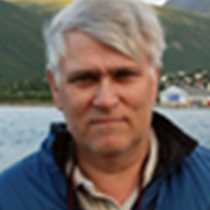Bjørnøya, Barents Sea
Early this morning, we slowly approached the isolated island Bjørnøya, more or less halfway between Nordkap (northern tip of Norway) and Sørkap (southern tip of Spitsbergen). Bjørnøya is included in the Spitsbergen Treaty, and at the northern tip is a small Norwegian radio & meteorological station manned throughout the year. In winter, nine people maintain the Norwegian sovereignty of the island. The island is of major strategic importance for Norway to control the enormous and productive Barents Sea, as well as a large future for petro-development. With the EEZ 200 nautical mile, Norway and Russia share the largest cod fishery in the world. In fact, Barents Sea is the second-most biologically productive sea in the world.
Our quest for the morning was the huge seabird cliff faces at the southern end. We hoped to get protection from the swell at Sørhamna and offer a Zodiac operation. As we arrived, it looked very bleak and we were pessimistic! Conditions were poor, with gusting winds, rain, and fog. Our expedition leader, Bud Lehnhausen, with many years of experience in the area, had the guts to stay calm and we spent the morning onboard waiting for the low pressure to pass by. During this time, we enjoyed a very inspiring presentation by Sisse Brimberg & Cotton Coulson, our National Geographic photography team, on how to improve your photography.
By lunch, the wind had dropped and the rain was gone, and by the time we had the Zodiac fleet in the water, we even saw blue sky and sun coming through. We proceeded to make a magical Zodiac cruise along the enormous bird cliffs. And, to make the adventure even more exciting, we went into caves and arches. Few places can offer such opportunities for excitement in a Zodiac.
All the auks had already departed for the sea, as they are really pelagic seabirds, and it is out in the ocean where they really want to be. Breeding is something which forces them to approach land, as no seabird has so far been able to find a way to carry the egg or chick on its back. Perhaps murres (guillemots) are on their way to this development? They force the chicks to jump off the nesting ledges on the cliff long before they are able to fly, and the males then swim out to sea with their chicks to the feeding areas, and continue to feed the chicks.
For a long time every summer people from northern Norway used to come up to Bjørnøya,to harvest eggs in huge numbers, but this ended 1971. Now, it is the capelin fishery that has an impact on the seabird populations, as capelin are an important food for the seabirds and marine mammals, but are also used for making pellets to feed farmed salmon. A future issue will soon be how petro-development in the Barents Sea will impact the seabirds using the extremely rich waters as their feeding and breeding grounds throughout the Arctic summer.
Fortunately for the bird watchers among us, fulmars, glaucous gulls, black-legged kittiwakes, and great skuas were still around. The kittiwake chicks were just learning to fly and we saw several fledglings practicing their new skill. They still have a long way to go until they master this ability and now they are easy prey for hungry glaucous gulls and great skuas.
After our magical Zodiac adventures, we made a brief landing at Walrosbukta in the late afternoon. It was a new experience for us to be able to walk in any direction on our own, as up north we had to stay in groups with armed escorts. Bjørnøya (Bear Island) was named by W. Barentz who found the island in 1596 and killed a polar bear. Nowadays, polar bears only occur here during winter, and only if the sea ice reaches this far south. Because of the climate change it happens more and more rarely.
During the hike at Walrosbukta, we found remains from earlier human efforts to occupy and use the island. In the early 20th century, 1905-08, attempts were made to establish a whaling station, but as much richer hunting grounds opened up at the Antarctic Peninsula all was moved south. Here, we also found walrus bones dating back to the earlier times as the Dutch and English whalers massacred walrus in numbers to be counted in the thousands. Some old graves were found higher up on the slopes, dating back to the walrus slaughter. Different hunting parties did fight over the living marine treasures, walrus tusks, skin and blubber.
Too soon, we had to depart our expedition and continue south. For dinner, our Filipino galley team offered up an amazing buffet meal. Those who still had energy left were able to watch our first sunset of the expedition, which turned into a nice green flash. The day started out grey and ended at its best…a true expedition day!




